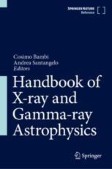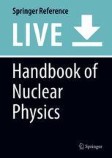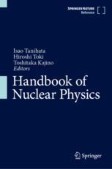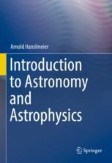Search
Search Results
-

-
An aspherical distribution for the explosive burning ash of core-collapse supernovae
It is widely believed that asphericity in the explosion is the crucial ingredient leading to successful core-collapse (CC) supernovae. However,...

-
Strong Gravitational Lensing and Microlensing of Supernovae
Strong gravitational lensing and microlensing of supernovae (SNe) are emerging as a new probe of cosmology and astrophysics in recent years. We...

-
Stellar Evolution, SN Explosion, and Nucleosynthesis
Massive stars evolve toward the catastrophic collapse of their innermost core, producing core-collapse supernova (SN) explosions as the end products....
-
Thermonuclear Explosions of Pair-Instability Supernovae Induced by Electron–Positron Pairs and Neutrinos
Very massive-low metallicity stars are predicted to explode as a Pair-Instability Supernova (PISN). The production of electron–positron pairs and...

-
Dust from supernovae and their progenitors in the solar nebula
Pristine stardust grains from the interstellar gas and dust cloud from which our Solar System formed some 4.57 billion years ago are present in small...

-

-
On Possibility of Star Formation Triggered by Multiple Supernovae in Dwarf Galaxies
Abstract —Superbubbles driven by supernovae explosions are sometimes considered as a source of triggering star formation. Using three dimensional...

-
Supernova Explosions from Accretion Disk Winds
Winds blown from accretion disks formed inside massive rotating stars may result in stellar explosions observable as Type Ibc and Type II supernovae....
-
Stellar Evolution, SN Explosion, and Nucleosynthesis
Massive stars evolve toward the catastrophic collapse of their innermost core, producing core-collapse supernova (SN) explosions as the end products....
-
Neutrino Spectra of Magneto-Rotational Supernovae and Observations Using Large-Volume Telescopes
AbstractThe dynamics of neutrinos in hot and dense magnetized matter, corresponding to a magneto-rotational explosion of supernovae, is considered....

-
Modern Stellar Astronomy 2022
AbstractWe provide an analytic review of problems of the modern stellar astronomy, which is mostly based on talks presented at the twelfth annual...
-
Progress in Supernovae Studies with the 2.5-m Telescope at the Caucasus Mountain Observatory of SAI MSU
AbstractWe present photometric and spectrocsopic observations of supernovae carried out with the 2.5-m telescope of the Caucasus Mountain Observatory...

-
Nucleosynthesis in Jet-Driven and Jet-Associated Supernovae
In contrast to regular core-collapse supernovae, explosions of rapidly rotating massive stars can develop jets, fast collimated outflows directed...
-
Nucleosynthesis in Jet-Driven and Jet-Associated Supernovae
In contrast to regular core-collapse supernovae, explosions of rapidly rotating massive stars can develop jets, fast collimated outflows directed...
-
Nucleosynthesis and Tracer Methods in Type Ia Supernovae
Type Ia supernovae (SNe Ia) are explosions of white dwarf stars in interacting binary systems, powered by thermonuclear fusion of lighter elements...
-
Nucleosynthesis and Tracer Methods in Type Ia Supernovae
Type Ia supernovae (SNe Ia) are explosions of white dwarf stars in interacting binary systems, powered by thermonuclear fusion of lighter elements...
-
Stellar Evolution
In principle, there are the following stages in stellar evolution:...
-
Supernovae
The visual recognition of the first supernovae (now called “historical”) in the West dates back to the Middle Ages. Previously, supernovae that...
-
Origin of the elements
What is the origin of the oxygen we breathe, the hydrogen and oxygen (in form of water H 2 O) in rivers and oceans, the carbon in all organic...

